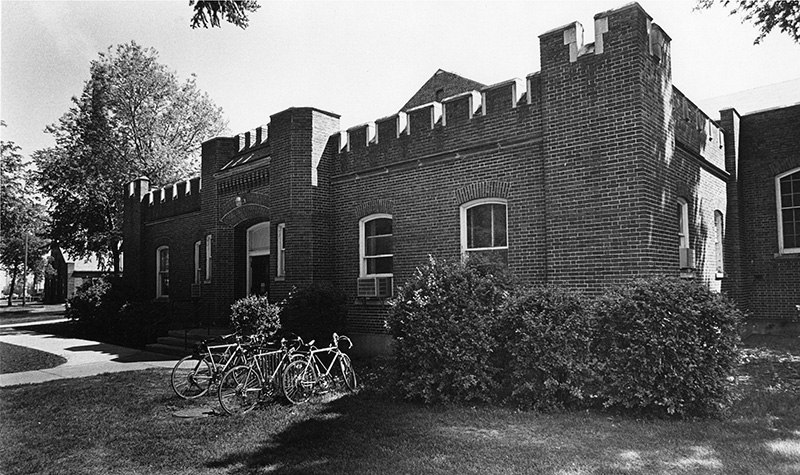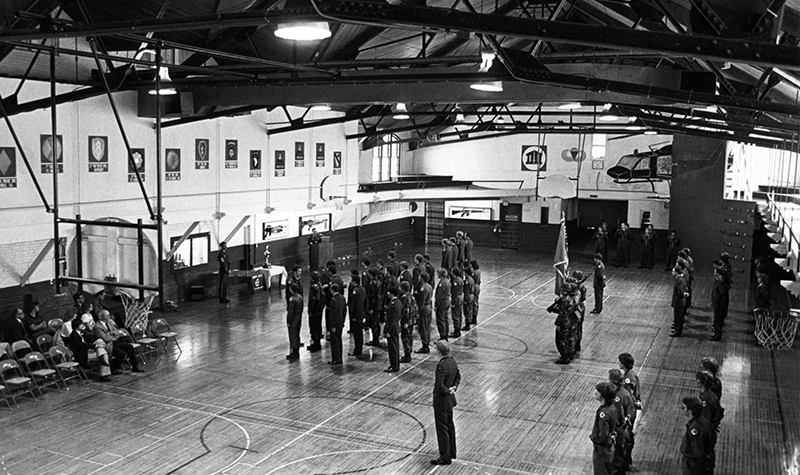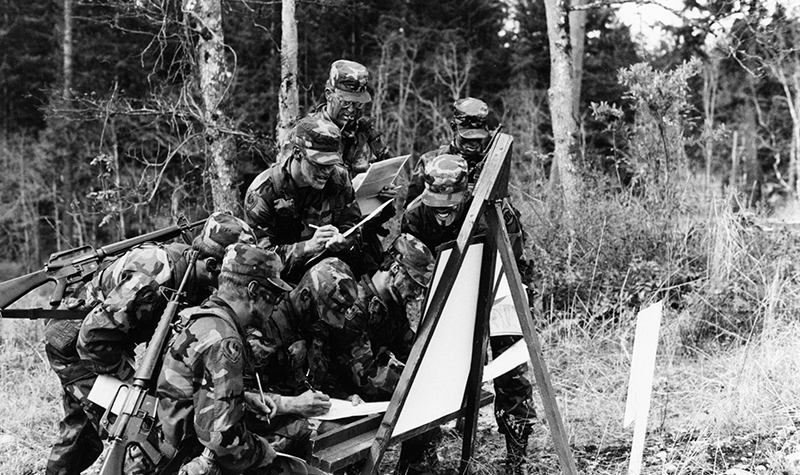06 Oct Army ROTC at UND celebrates its centennial this Homecoming Week

The Armory has overlooked the University’s quad for 100 years. Archival photo.
Lt. Col. Jason Murphy was once simply Jason Murphy, a freshman at the University of North Dakota and a cadet in the school’s Army Reserve Officer Training Corps (ROTC).
In the 1990s, in Murphy’s freshman eyes, seniors carried themselves so maturely. The Armory, which houses Army ROTC, stood a bit sturdier than today – with an indoor shooting range and no damage from the momentous 1997 flood.
The 1996 graduate arrived at UND on the 75th anniversary of Army ROTC. This academic year marks another propitious time to be on campus for the Lieutenant Colonel – the centennial of Army ROTC, which he returned to lead in 2016.
“UND is a home,” Murphy said. “It’s where good people and great leaders come from. And, I think that’s what really makes it a great thing to be part of UND Army ROTC. Our mission is to produce leaders of character, and character starts long before they’ll ever come to me.
“UND has leaders of character.”
To celebrate a century of nurturing leadership, Army ROTC has assembled a schedule of events, commencing with an Open House on Friday, Oct. 4, followed by a dinner. At the dinner, two other UND alums – Brig. Gen. Jackie Huber ’92 of the North Dakota National Guard, as well as Dennis Elbert ’68, dean emeritus of the College of Business & Public Administration – will share their recollections of Army ROTC.
On Saturday, Oct. 5, Army ROTC will join the Annual UND Homecoming Parade, which will march east down University Avenue from the Gorecki Alumni Center to University Park..
And to help readers appreciate the festivities, here’s how UND and Army ROTC fostered their partnership over the past 100 years.
The start
The largest officer-generating initiative of the U.S. military, Army ROTC traces its origins to the early 19th century, when Capt. Alden Partridge, an early superintendent of the U.S. Military Academy at West Point, hatched the notion of training “citizen-soldiers” while the cadets earned degrees at other higher-education institutions. The cadets then could enter the Army or forge civilian careers.
Before the Land Grant Act of 1862, which set aside federal land for public universities in exchange for the schools providing military tactics training, a handful of colleges had already incorporated ROTC units. Those included Lafayette College in Pennsylvania, Indiana University and the University of Tennessee, among others.
At UND, President Homer Sprague, a one-time solder in the Civil War who lead the University from 1887 to 1891, established military training along with several athletic programs.
On campus, Army ROTC has its predecessor in the Student Army Training Corps (SATC), which briefly transformed the campus into a military compound toward the end of World War I. At the onset of the academic year in 1918, UND was to accommodate some 400 student soldiers, transform several dormitories into barracks and turn the Phi Delta Theta house into Army headquarters.

Army ROTC cadets in the Armory’s gymnasium, circa 1983. Archival photo.
But with an influenza epidemic sweeping in and the war suddenly coming to a halt, SATC never really took off in Grand Forks. The SATC drill hall, undertaken with a federal grant of $11,000, sat unfinished until, in 1919, a $35,000 state appropriation helped complete it into the Armory.
The same year, the Department of the ROTC materialized, along with a new chemistry building, a commerce program and expanded law and medical schools.
“I think what’s amazing is that the Armory has been here for 100 years,” said Murphy. “We’ve been producing leaders for 100 years. And, we didn’t need a huge change in facilities to produce leaders because it’s a human endeavor to train, educate, and commission leaders of character into the Army.”
Part of campus
In the early 1900s, military training was compulsory for male students. But, mere months after the end of the Great War, some on the UND faculty questioned this directive. Their opposition was so robust that University President Thomas Kane gave the faculty the ability to vote out Army ROTC if it proved unworkable.
In 1919, the concession nudged the Faculty Council to approve the establishment of Army ROTC at UND.
Despite the evolving notions of war and pacifism that swirled across campus over the decades, Army ROTC quickly wove itself into the social fabric of UND. Only a year after its inauguration, ROTC sponsored the first vanity contests at UND, which selected “the nine most popular girls at the University,” wrote Louis Geiger in his 1958 work, University of the Northern Plains.
And a decade after ROTC’s arrival, the “Best of the Best” titles that students awarded to faculty included an ROTC instructor, Sgt. Edmund T. McCann.
In 1925, ROTC’s Capt. Lawrence Quinn took over the Student Affairs Committee to supervise social activities and organizations.
New tide
In 1937, swayed by North Dakota U.S. Sen. Gerald Nye’s investigation into the munitions industry and the causes that pushed the nation in the First World War, the Peace Garden State abolished compulsory ROTC training at UND and North Dakota State University, then the Agricultural College. As a result, ROTC enrollment dropped by half.
Some five years later, after America got involved in World War II, UND students began registering for the draft. By spring 1944, few men remained on campus, which had once again been turned into a base for the war efforts.

Army ROTC cadets in the middle of drills. Archival photos.
The faculty in Grand Forks offered training to nearly 6,000 military personnel, including nurses, radio operators, engineers and pilots. In 1945, when the war ended, the Armory housed about 70 German prisoners of war – a situation that put a stop to men’s indoor P.E. classes for some six months.
Lasting relationship
In 1965, UND President George Starcher and the Army inked a contract for the ROTC program, a document that was just recently renewed, said Murphy.
“That contract included the rifle range and a requirement that the University Band would come and play at commissioning ceremonies,” he said.
The following decade saw unrest on many campuses, including UND. The Vietnam War and the shooting of Kent State students by soldiers from the Ohio National Guard spurred nationwide demonstrations. At UND, students protested in front of the Armory.
In response to the crowd, President Thomas Clifford emerged from the Armory’s door to address the gathering. He proclaimed that he would meet with students on a regular basis for what became known as “Chats with the President.”
The early 1980s brought another change to Army ROTC at UND. Some observed that the long, frigid winters weighed particularly heavy on UND’s female students, who had few outlets for physical exercise once snow came. Hence, in 1981, military drills became available to women.
Through the years, as both UND and Army ROTC progressed together, forming one of more than a thousand U.S. Army/higher education partnerships across the country, it has been the unique facets of both organizations that have shaped the history.
“I think it’s a mixture of the friendliness, the willingness to support one another, the wide and diverse set of degree programs that all contribute to this success,” said Murphy. “The campus is very military friendly, and the community is very military friendly. Those things make a big difference.”


